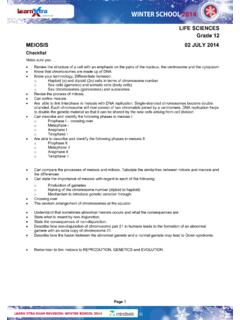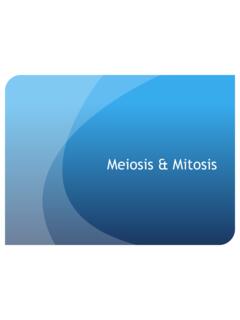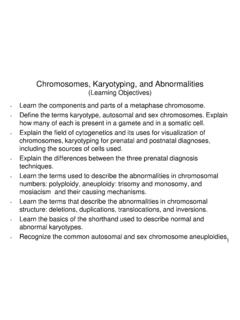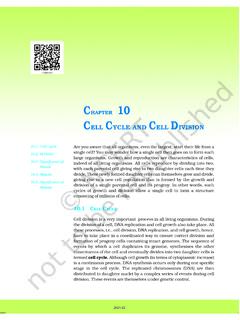Transcription of ExamView - 06c. Mitosis & Meiosis Practice Test
1 Name: DO NOT WRITE ON THIS TEST Class: ALL ID: A. Mitosis & Meiosis Practice Test Modified True/False Indicate whether the statement is true or false. If false, change the identified word or phrase to make the statement true. ____ 1. Stage 1 of the cell cycle is labelled on the diagram below. The name of this stage is interphase. _____. ____ 2. The stage of the cell cycle in which the cell grows and produces new organelles as needed is called interphase. _____. ____ 3. The process in which the contents of a cell's nucleus divides is Mitosis . _____. ____ 4. During the process of Mitosis each pair of identical DNA molecules joins together to form sister chromatids. _____. ____ 5. During Mitosis the sister chromatids join together at the centriole. _____. ____ 6. Special proteins monitor the success of the cell cycle once it is complete, but not during the cycle. _____. ____ 7. Cancer cells grow in multiple layers because neighbouring cells don't tell them to stop.
2 _____. ____ 8. Cancer cells are specialized cells that take over the role of normal organ cells. _____. ____ 9. Human gametes have 23 chromosomes. _____. ____ 10. When a single cell undergoes Meiosis , four gametes are produced. _____. 1. ____ 11. A gamete is a diploid cell. _____. ____ 12. When a chromosome from one parent is matched up with a chromosome from the other parent, upon zygote formation, the chromosomes are said to be homologous. _____. Multiple Choice Identify the choice that best completes the statement or answers the question. ____ 13. Cancer is an example of a) a recessive trait. b) a trait that shows continuous variation. c) a dominant trait. d) the effect of a genetic mutation in body cells. ____ 14. Where in the cell are the chromosomes located? a) nucleus c) chloroplasts b) vacuoles d) cytoplasm ____ 15. The nucleus of every cell contains deoxyribonucleic acid, which is also known as a) DNA. c) RNL.
3 B) RNA. d) DRA. ____ 16. New body cells ( , skin, muscle) are produced by a) Mitosis . c) eggs. b) Meiosis . d) fertilization. ____ 17. Mitosis produces a(n). a) sperm. c) pair of identical cells. b) egg. d) gamete. ____ 18. Mitosis is the process by which a) a zygote is produced. b) sperm are produced. c) a body cell makes an exact duplicate of itself. d) gametes are produced in the ovaries or testes. 2. ____ 19. Stage 2 of the cell cycle is labelled on the diagram below. What is the name of this stage? a) Mitosis c) interphase b) telophase d) cytokinesis ____ 20. The process in stage 3 in the cell cycle diagram below shows the process of a) replication. c) interphase. b) cytokinesis. d) Mitosis . 3. ____ 21. The stage of Mitosis during which the nucleolus and nuclear membrane disappear is a) anaphase. c) metaphase. b) prophase. d) telophase. ____ 22. The diagram below shows a) the steps of metaphase. c) the cell cycle.
4 B) Mitosis . d) Meiosis . ____ 23. While looking through a microscope you observe the following: What is the name of this stage of the cell cycle? a) cytokinesis c) anaphase b) telophase d) interphase 4. ____ 24. While looking through a microscope you observe the following: What is the name of this stage of the cell cycle? a) interphase c) anaphase b) cytokinesis d) telophase ____ 25. While looking through a microscope you observe the following: What is the name of this stage of the cell cycle? a) late prophase c) early prophase b) anaphase d) telophase ____ 26. DNA is duplicated during this stage of the cell cycle identified as a) replication. c) interphase. b) cytokinesis. d) prophase. ____ 27. The three stages of the cell cycle are identified as a) replication, growth, and cytokinesis. b) prophase, metaphase, anaphase, and telophase. c) growth, replication, and Mitosis . d) interphase, Mitosis , and cytokinesis. ____ 28.
5 Most of the cell's growth occurs during a) prophase. c) interphase. b) cytokinesis. d) telophase. 5. ____ 29. The chromosomes are pulled into a single line across the middle or equator of the cell during a) metaphase. c) anaphase. b) prophase. d) telophase. ____ 30. The tiny tube-like structures, which are made of proteins and are found in the cell during Mitosis , are a) centrioles. c) centromeres. b) spindle fibres. d) chromatids. ____ 31. Cells are not likely to divide if a) there are not enough nutrients to support cell growth. b) the DNA has been damaged in any way. c) the DNA within the nucleus has not been replicated. d) any of the above are true. ____ 32. Cell cycle control may be lost if a) the cells grow in a single layer. b) specialized cells form during the cell cycle. c) a mutation occurs in the gene producing checkpoint proteins. d) the cell is exposed to a small amount of fluorescent light. ____ 33. Sexual reproduction a) is found only in animals.
6 B) creates variations among individuals. c) produces genetically identical individuals. d) enables organisms to produce many offspring very quickly. ____ 34. Each inherited characteristic is determined by genes passed on from a) the mother and her parents. c) the father and his parents. b) the mother only. d) the father and mother. ____ 35. Which process is shown in the illustration above? a) fertilization c) Meiosis b) genetic engineering d) Mitosis ____ 36. How many chromosomes do human beings have in each of their body cells? a) 46 c) 23. b) 92 d) 52. 6. ____ 37. Which process produces gametes? a) variation c) Meiosis b) Mitosis d) fertilization ____ 38. How many chromosomes are there in the nucleus of a human sperm cell? a) 22 c) 23. b) three d) 46. ____ 39. A gene is a) another name for a chromosome. b) a tightly coiled strand of DNA. c) the result of Meiosis . d) a section of DNA that codes for a specific protein.
7 ____ 40. Which of the following is a source of variation in sexual reproduction? a) The random division of chromosome pairs into gametes b) The duplication of genetic material before Mitosis c) The combination of gametes from two parents d) Both A and C. ____ 41. A cell produced by Meiosis has a) twice as many chromosomes as the mother cell. b) the same number of chromosomes as the mother cell, but each cell is half its original size. c) the same number of chromosomes as the mother cell. d) half as many chromosomes as the mother cell. ____ 42. Sperm and eggs are produced by a) Mitosis . c) asexual reproduction. b) Meiosis . d) fertilization. ____ 43. Which statement below best describes the process of Meiosis ? a) A sperm penetrates an egg to form a zygote. b) Cells with only half the original number of chromosomes are produced. c) Muscle cells turn to fat cells as a result of a lack of exercise. d) Skin cells are replaced as they wear away.
8 ____ 44. Meiosis is often referred to as reduction division because a) the total number of cells is reduced after Meiosis . b) the daughter cells are smaller than the mother cell. c) the total number of chromosomes is reduced by two. d) the daughter cells have half the number of chromosomes. ____ 45. New body cells ( , skin, heart, nerve) are produced by a) Meiosis . c) Mitosis . b) fertilization. d) eggs. ____ 46. The order which chromosomes line up at the equator during Meiosis I is random. What term do we have to describe this event? a) genetic diversity b) independent arrangement c) crossing over d) independent assortment. 7. ____ 47. Segments of DNA that are parts of non-sister chromatids are sometimes exchanged in a process referred to as a) gene swapping. c) DNA exchange. b) crossing over. d) chromatid mutation. ____ 48. A cell that has two sets of chromosomes is described as being a) haploid. c) complete. b) diploid.
9 D) zygote. ____ 49. A cell that has one set of chromosomes, which were contributed from a single parent, is described as being a) diploid. c) complete. b) fertilized. d) haploid. ____ 50. After fertilization occurs, the chromosomes from one parent match up with the chromosomes from the other parent. These matching chromosomes are described as a) mated. c) partnered. b) homologous. d) offspring. 8. ID: A. Mitosis & Meiosis Practice Test Answer Section MODIFIED TRUE/FALSE. 1. ANS: T PTS: 1 DIF: Easy OBJ: Section TOP: The Cell Cycle and Mitosis KEY: interphase | cell cycle 2. ANS: T PTS: 1 DIF: Average OBJ: Section TOP: The Cell Cycle and Mitosis KEY: interphase | cell cycle 3. ANS: T PTS: 1 DIF: Average OBJ: Section TOP: The Cell Cycle and Mitosis KEY: Mitosis 4. ANS: T PTS: 1 DIF: Difficult OBJ: Section TOP: The Cell Cycle and Mitosis KEY: Mitosis | chromatids 5. ANS: F, centromere PTS: 1 DIF: Average OBJ: Section TOP: The Cell Cycle and Mitosis KEY: Mitosis | chromatids | centriole | centromere 6.
10 ANS: F, and PTS: 1 DIF: Average OBJ: Section TOP: The Cell Cycle and Mitosis KEY: cell cycle | proteins 7. ANS: T PTS: 1 DIF: Average OBJ: Section TOP: The Cell Cycle and Mitosis KEY: cancer 8. ANS: F, not specialized, so they cannot take over PTS: 1 DIF: Average OBJ: Section TOP: The Cell Cycle and Mitosis KEY: cancer | specialized 9. ANS: T PTS: 1 DIF: Average OBJ: Section TOP: Meiosis KEY: gamete | chromosome 10. ANS: T PTS: 1 DIF: Easy OBJ: Section TOP: Meiosis KEY: Meiosis | gamete 11. ANS: F, haploid PTS: 1 DIF: Average OBJ: Section TOP: Meiosis KEY: gamete | diploid | haploid 12. ANS: T PTS: 1 DIF: Average OBJ: Section TOP: Meiosis KEY: chromosomes | homologous | Meiosis | zygote MULTIPLE CHOICE. 13. ANS: D PTS: 1 DIF: Average OBJ: Section LOC: LS-R-01 TOP: The Cell Cycle and Mitosis KEY: cancer | mutation | genetic 14. ANS: A PTS: 1 DIF: Easy OBJ: Section LOC: LS-R-01 TOP: The Cell Cycle and Mitosis KEY: chromosomes | nucleus 15.






